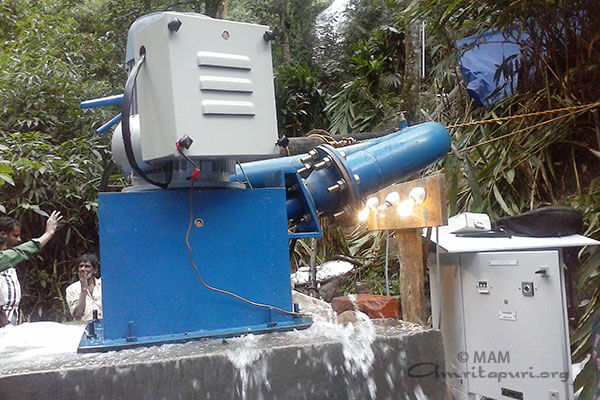Last September, in her birthday address, Amma pointed out that India is suffering from a split personality–success when it comes to technological advancement and failure in terms of poverty, illiteracy, health sanitation and crimes against women. “A split personality is never a sign of sound health,” Amma said. “If we want to see India become powerful and healthy again, we need to merge these two faces into one beautiful face… If we can bring our collective knowledge, compassion and talent together, it will not be so long before we see India rising and thriving with peace, harmony and prosperity.” {news}

For Amma, actions are at least as important as words. As Chancellor of Amrita University, she has fostered the institution’s robust, highly acclaimed research and development with a laser-like focus on humanitarian goals and deployment in the field. Under Amma’s guidance, the university is a trailblazer in the humanitarian application of emerging technologies.
In just one of many examples, staff and students of Amrita University, along with members of Amrita Self Reliant Villages (AmritaSeRVe) worked with residents of Komalikudi, one of the 101 villages adopted by the Mata Amritanandamayi Math (MAM), to identify key challenges that needed to be addressed. Approximately one third of India’s 600,000 villages do not have access to electricity. Komalikudi, a tribal settlement in Kerala well-known for its abundant natural resources, is one such village. After assessing the requirements of the village, a plan was implemented to provide electricity to the village from available hydro resources.

The team designed, developed, and installed a distribution and transmission network which included: a check dam, a network of pipes, a 5KW micro hydro generator, an underground transmission line, and a power house. This initiative of the University helped students to apply theoretical knowledge to address and solve real world challenges faced by rural communities in India. In the process, they greatly improved the lives of the people of Komalikudi and themselves underwent a life-changing experience of service-oriented innovation. The experience awakened love and compassion in their hearts as they worked together to find creative solutions to the problems of the villagers, harnessing the power of the available resources to make targeted improvements in the infrastructure of the village.
In Komalikudi, the new micro hydro generator, constructed near the perennial water stream, currently provides 24/7 electricity. Each home has four connection points with 3 lighting points and a plug point. Villagers currently use energy efficient 7 watt LED bulbs for energy conservation.
A vocational skills trainer in Komalikudi, Mrs. Shobana, said, “Earlier we had to stop our work by 5 p.m. as there was no light in the room. Now we have electricity so we can work at night. We are so grateful to Amma and her children for the help.” Echoing her sentiments, Mrs. Vellamma, a volunteer at the village’s Anganwadi said, “Now we have lights in the room so students can study at night – many thanks to Amma. We are so grateful to Amma for the support.”
In addition to access to electricity, the Amrita team designed and installed a water distribution system in the village which includes a bore well with a pump and two overhead water tanks connected to each cluster of homes through pipes. The entire water distribution framework is currently powered by the micro hydro generator. The villagers now have access to potable water throughout the year which has helped their lives to improve greatly {news}, particularly seen in the areas of sanitation and education. Access to sanitation facilities also increases the overall health of the village and encourages children and adults to adhere to better hygiene practices, greatly improving public health outcomes.
[av_table purpose=’tabular’ pricing_table_design=’avia_pricing_default’ pricing_hidden_cells=” caption=’The details of the mini Hydro project in Komalikudi village’ responsive_styling=’avia_scrollable_table’ av_uid=’av-83ow1ou’] [av_row row_style=” av_uid=’av-7jasksu’][av_cell col_style=” av_uid=’av-6zz9zwu’]Population[/av_cell][av_cell col_style=” av_uid=’av-6r1u2em’]Houses[/av_cell][av_cell col_style=” av_uid=’av-64uwhqm’]Pipe L&H[/av_cell][av_cell col_style=” av_uid=’av-5mdc0ku’]Transmission Length[/av_cell][av_cell col_style=” av_uid=’av-5aaj5hq’]Network[/av_cell][av_cell col_style=” av_uid=’av-4z5jpke’]Members[/av_cell][av_cell col_style=” av_uid=’av-4724j3i’]Labour hours[/av_cell][/av_row] [av_row row_style=” av_uid=’av-3w9pc1a’][av_cell col_style=” av_uid=’av-3ahrvta’]350[/av_cell][av_cell col_style=” av_uid=’av-35ibu32′]90[/av_cell][av_cell col_style=” av_uid=’av-2efp8su’]82×30 M[/av_cell][av_cell col_style=” av_uid=’av-24bbyku’]1000 M[/av_cell][av_cell col_style=” av_uid=’av-1k8hl0u’]320 M[/av_cell][av_cell col_style=” av_uid=’av-1brjcz2′]49[/av_cell][av_cell col_style=” av_uid=’av-od9fgu’]8.500 +[/av_cell][/av_row] [/av_table]
Invalid Displayed Gallery


